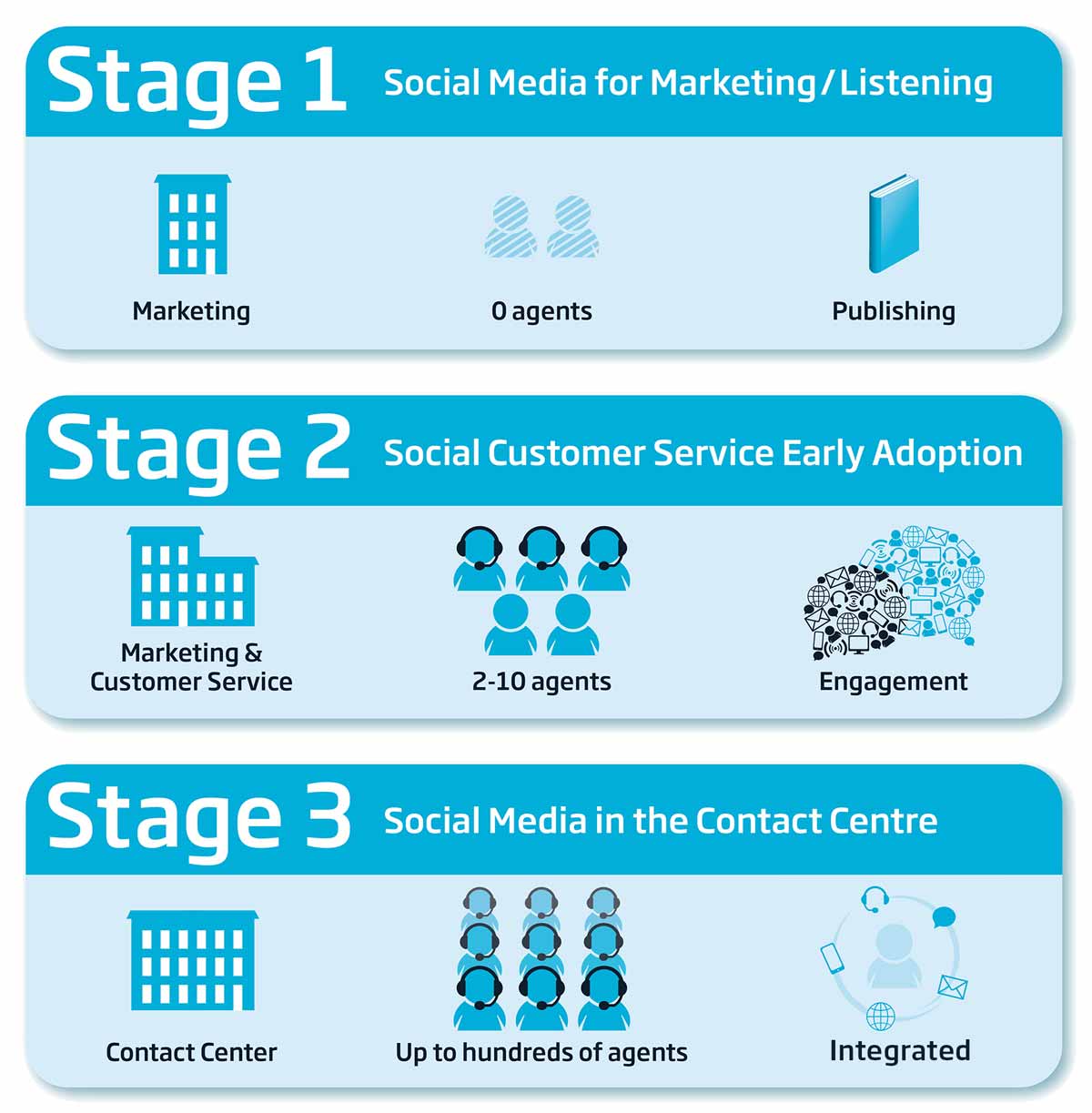When it comes to customer service over social media, today’s customers are more demanding than ever of the companies they know and love. As the social landscape evolves, your customers increasingly expect more from the conversations they are having on social networks like Facebook and Twitter. To meet this new customer expectation, contact center executives polled in a recent survey from Forrester Consulting indicated that improving social customer service is their most pressing short-term priority.
However, although adoption of social customer care programs increased from 12% in 2010 to 59% in 2013, companies are still at many different levels of social media maturity. In our experience, we find that it's helpful to think of this as a three-stage journey.
Stage 1 – Social Media for Marketing/Listening
In stage 1, social media is purely a marketing activity, used for outbound publishing and promotion only. If – and that’s an if – customer service issues are addressed at all, it’s typically an indirect process, where marketing will relay an issue to some customer service contact, who will work on it along with their typical workload, and will either relay an answer back to marketing or contact the customer another way. So, no direct interaction with the customer on social channels.
As a rule, this stage generally delivers a terrible customer experience. First contact resolution is one of the most important attributes for a great customer experience – this is neglected through ignorance or deflection. Companies also push customers from a high efficiency/low cost channel to more expensive traditional methods. Fundamentally, the customers are not being taken seriously – with businesses failing to maximize the efficiency and impact social customer service has.
Stage 2 – Social Customer Service Early Adoption
In stage 2, marketing still owns the social media operation, but recognizes that they should engage with inbound customer comments and queries. They typically achieve this by getting a small number of agents to help them out. The agents are usually just enough to deal with incoming volume and are in effect 'on loan' to marketing.
Usually at this stage the social customer service team uses whatever tool the marketing team provides or works from, and are usually only managed in a basic manner, with few strict processes or KPIs. We began to see a rapid increase in the amount of companies reaching stage 2 at the beginning of 2012. Our latest analysis shows around 50% of companies are at this stage.
While customers are being helped, this basic coverage combined with the wrong software and few processes mean response times are slower than consumers expect.
Stage 3 – Social Media in the Contact Center
In stage 3, social media is a fully integrated and highly efficient customer service channel in the contact center, usually owned by the COO, head of customer service and experience. Social media activity is measured by customer service metrics and KPIs like average handling time and first response time in order to ensure they are delivering the experience customers expect.
More and more brands are moving into stage three of their social customer service development – where the business as a whole recognizes that social media is a primary customer service channel, alongside email, phone and chat. When this happens, responsibility for managing social media channels is transferred to the Contact Center to manage properly. Doing so ensures the appropriate technologies are in place to deliver excellent customer service.
Making it to the next stage
The public nature of social media means that each successful interaction has the potential to be amplified into a peer-to-peer recommendation, delivering marketing benefit that is significantly greater than other channels. Research from NM Incite, a partnership between Nielsen and McKinsey & Company, found that consumers who encounter positive social customer care experiences are nearly three times more likely to recommend a brand than those who do not.
However, without the right resources, commitment and leadership in place, customer service can present a huge risk for brands of all sizes. Therefore, companies must deeply embed their social customer service operation internally – taking all the steps necessary to minimize risk. If done correctly, you will increase your customer value and customer satisfaction while reducing costs and improving your business processes.
Are you ready to make it to Stage 3?
As a starting point, please be sure to attend our session at ICUC on Wed, September 24th at 3:00 pm. We have also written a Definitive Guide to Social Customer Service to help you turn social media into a standardized, scalable and ROI-positive operation that lives up to your brand’s promise of quality service.
Joshua March founded Conversocial in 2009 based on his vision that online communication and customer service was undergoing a fundamental shift, requiring businesses to invest in new processes and technologies to manage the rapidly shifting social landscape.
A leading proponent of social media, Joshua previously founded leading social application company iPlatform, one of the worlds first Facebook Preferred Developers, which was acquired in 2012. Having started his career in London, Joshua is now based in New York where he leads the US operations of Conversocial, as well as global strategy.




